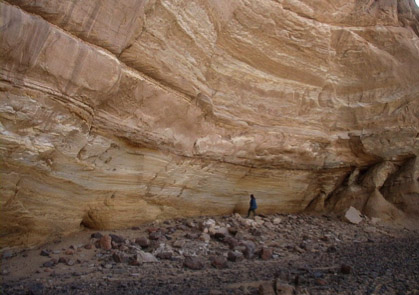Using AI to control energy for indoor agriculture
30 September 2024
Published online 21 March 2018
Plant remains from the Libyan Desert reveal that our ancestors cultivated weedy crops.

© University of Huddersfield
Around 7500 BC, the climate of the Sahara shifted. Wet, rainy conditions transformed the desert into a savanna known as the ‘green Sahara’. The savanna lasted for roughly 4,000 years before the climate dried and the desert returned. By studying the remains of human settlements in the green Sahara, archaeologists and archaeobotanists learn how hunter-gatherers and pastoralists lived in the area and how they coped with and contributed to the region’s environmental changes.
Now, an international collaboration led by researchers at the University of Modena & Reggio Emilia and the University of Rome investigated plant remains found in the Takarkori rock shelter in the desert of southwest Libya, from pollen grains to seeds and fruit to the plants woven into baskets or burnt to charcoal.
The researchers examined 30 piles of dried seeds deposited around the site. Radiocarbon dating gave the team an estimate of the age of each pile, and entomological analysis revealed no sign that they had been made by insects. Ancient humans had left these seed piles, which we can use to glimpse back into their lives.
Cereal grains were predominant in the piles, though there were also remains of some woody fruit plants such as fig and jujube.
The researchers classified the piles into ‘spot’ and ‘mix’ accumulations. The spot accumulations consisted of cleaned seeds which had probably been stored for consumption (or perhaps cultivation), while the mix accumulations contained waste fragments from processing.
“The plants were a resource for almost every aspect of life,” says Anna Maria Mercuri, who led the archaeobotanical side of the study.
The contents of the seed piles also revealed a shift between the collections made by hunter-gatherers around 6400 BC and pastoralists around 4900 BC. Not only did the pastoralists collect significantly more seeds, but they also introduced a new species, jungle rice, which became quite abundant and replaced liverseed as the main cereal.
“The most interesting aspect of these findings is the extent to which plants were managed in these societies,” says Cindy Vigueira, an evolutionary biologist at High Point University who wasn’t involved in the study.
Many of the remains were from species that we would consider ‘weedy’ – invasive, opportunistic plants that people at the site would have cultivated and managed but never domesticated.
“This paper is a great resource for understanding the pre-domestication management of food plants by humans in Africa. Including plants that were managed by humans but did not make the ‘cut’ is novel and important to our understanding of the domestication process,” says Vigueira.
For Mercuri, “the most surprising thing from our modern perspective is that the traits selected in the past were different from those we prefer today: not the largest seeds but plants that were easier to grow. This was what our ancestors, with wisdom, preferred in order to survive in changing environmental conditions, such as decreasing water availability.”
Hunter-gatherers and pastoralists at Takarkori were attracted to certain plant species because of their weedy traits, characteristics which have since been bred out of domesticated crops.
Not only do these findings shed light on the middle ground between foraging and farming, but they also highlight the potential value of weedy species as valuable food resources in the face of climate change and desertification. Many of these species continue to be cultivated in Africa today, and the researchers write that “we should pay renewed attention to these plants in the hope of finding innovative responses to tackle desertification and biodiversity loss.”
doi:10.1038/nmiddleeast.2018.30
Stay connected: